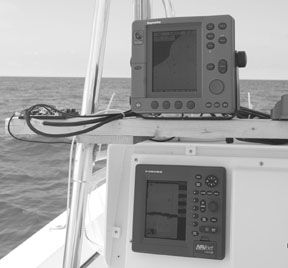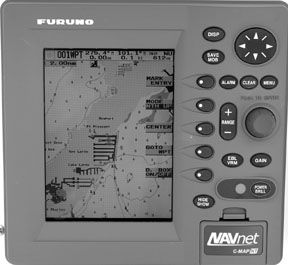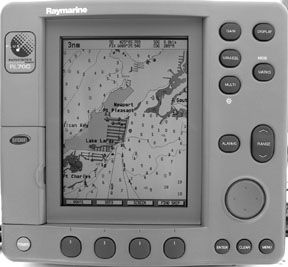Networked electronics are all the rage today and for good reason—versatility. You can start small and add on later, or install everything but the galley sink. These devices will display radar with ranges approaching 100 miles, interface with sounders rated up to 3000 watts, use multiple memory cards to display detailed chart information for whole continents at a time, and even display video or weather fax information—all on quality screens up to 15 inches.

Along with all this versatility come a lot of choices. You’ll need to put serious thought and planning into designing a system tailored to your needs. Like building a house, some decisions you make up front can be quite costly to change at a later date. For instance, in this test we look at a pair of 7-inch display units. One is radar ready; all it needs to be used as a complete radar system is the scanner (antenna). Of course, this maker also markets a model that is not radar ready, but in all other respects is identical.
The other unit we tested is not capable of displaying radar information unless another unit on the same network is added. This manufacturer has another identical model that is radar ready. Deciding up front whether to add radar is important. If you say yes to radar, you’ll pay more. If you’re not sure, but want to keep your options open, you’ll need to buy a radar-ready display now so you can add the scanner later to complete the system.
The same holds true for chartplotting capability—not all displays have it. Sounders are different. They come in their own little black boxes and feed data to the network via cables. Adding one later is usually not a problem.
What We Tested
In our March 2004 issue, we published a review of these two networks with 10-inch screens. We focused on user-interface and did not test the respective units on the water. Now, we offer this more in-depth look at the systems.
These two smaller screen systems are suitable for use aboard the midsize sailboats that many of our readers own. Raymarine sent us a system it markets as the 7-inch Value Pak. It contains a display, sounder, transducer, GPS antenna, and a VHF radio. The display in the package is a radar ready unit that includes RayChart—Raymarine’s chartplotter. Our test system was configured for chartplotter/sounder duties. We did not have a radar antenna attached and did not test this portion of the display.
The Raymarine was matched against a networked system from Furuno. This plotter/sounder package also has a 7-inch screen.
How We Tested
Both units were tested aboard a 25-foot Contender runabout that we share with our sister publication Powerboat Reports. All the Furuno equipment, including the 7-inch display, black box sounder, GPS antenna, and all associated cabling, is now permanently installed for long-term testing.
A portable wooden rig was used to mount the Raymarine gear, including the 7-inch RL70C display with its supplied bracket. Also secured to the test rig was the DSM250 sounder box and an electric supply panel with the appropriate fuses. Another short section of wood held the GPS antenna. It was secured to the T-top at the same level as the Furuno antenna.
Viewability has always played a large role in the ratings and conclusions on units tested in the past. It does again here. Both displays were rated under a variety of lighting conditions, ranging from bright sunlight, to cloud-obscured daylight, andto nighttime conditions. Each screen was looked at from various angles, with and without polarized sunglasses, using different background color palettes, and from a range of sun angles. After the sun went down, each unit was given a night-view rating based on the screen’s viewability during twilight as well as later under total darkness.
Sounder evaluations were made over a known bottom structure. The same transducer was used to test both units. Airmar supplied crossover cables, allowing us to connect the proprietary transducer connections on each of our test units to the B44V 10-pin thru-hull tri-ducer permanently flush-mounted in our test boat. We rated both sounders in shallow water by cruising our home channel; it has a soft bottom with depths ranging from 10 to 20 feet, as well as a hard rock ledge that terminates in a depth of 3 feet. The channel contains several pieces of hard bottom structure, which added variety to the evaluation.
Deep-water testing had us returning to a steel wreck in 125 feet of water we’ve used for numerous prior sounder tests. All depth sounder testing was done in 79-degree salt water. We did not take these sounders out to their rated maximum depth for testing.
The plotter and sounder sections of each unit were rated for user interface based on each unit’s dials, buttons, cursor pads, joysticks, and software. The easier and more intuitive a unit was to use, the higher the rating.
Furuno
The Furuno consisted of a GP-1710C/NT color video plotter package equipped with a high resolution (640V x 480H) 6-1/2-inch diagonal screen, and a BBWGPS antenna. The BBFF1 sounder was added to provide plotter/sounder capability.
Overall dimensions on the display are 8-3/4 x 8-3/8 inches, with a depth just under 5-1/2 inches. The BBFF1 sounder supplies data to the screen via the NavNet network and can be set for either 600 or 1000 watts of output power. Ours was set at 600 watts. An infrared remote control is included in the GP-1710C package, but we did not test it.
The GP-1710C is flush-mounted in the instrument panel, and the BBFF1 is bulkhead-mounted inside the center console with the GPS antenna mounted on the T-top. Bracket mounting of the display unit is possible with the supplied bracket. Installation is certainly a more complex and time-consuming process with a networked system than with an integrated unit because of the added hardware and cabling. However, a boat owner with even limited mechanical and electronics know-how can install these systems.
Day viewability was rated excellent on the GP-1710C, though it’s just a tad less bright than the Raymarine. Using polarized sunglasses, we viewed the screen from head on and to angles of 45 degrees—the screen did not darken at all and could still be seen at angles approaching 60 degrees.
Our best test results were obtained in plotter mode when depth shading was turned off, displaying water areas in white. Using white for the water’s color also proved to be the best way to view the sounder display in daylight. We accomplished this by selecting Hue #5. Our night-view testing began in twilight conditions and continued until full darkness.

Leaving the screen in daylight palette and using the eight levels of brightness and contrast worked well to a certain point. To darken the screen further, we switched to the twilight palette and tinkered with brightness and contrast controls. As the sun fell further, we selected the night palette. Both the twilight and night palette use dark colors and seem similar in function to us. Control panel button backlighting is adjustable separately on the Furuno screen, yielding a bit more versatility here than in the night lighting of the Raymarine unit. We rated night viewing on the Furuno Good.
The most commonly used functions on the GP-1710C are controllable with dedicated pushbuttons or via the five soft keys. This limits the need to enter multi-layered menus. Here’s an example: A waypoint can be saved at the boat’s position by pressing the Save/MOB key momentarily; holding it for three seconds will activate the MOB function. Confirming the MOB function with the enter knob automatically selects full-screen plotter mode, draws a line to the MOB position, and displays MOB range and bearing.
All five soft keys normally operate at least two functions depending on the mode in use. One of these functions is user-selectable. The nomenclature describing functions for each soft key is displayed on screen next to each key in a large, easily readable font. Soft key labels can display either assigned function or be hidden from view. Waypoint, route, and menu lists are also displayed in an easy-to-read format and font. Onscreen data box information is also user-selectable and the boxes can be moved, displayed, or hidden.
Manual data entry requires scrolling through number, letter, and symbol lists, a process described in previous PS plotter articles as slow and tedious, and it is here as well. The Enter knob on the Furuno does rotate, however, making number and letter selections somewhat faster. Fortunately, other data entry and transfer methods are available as options. It’s easiest to move waypoint and route lists to and from a home computer using compatible chartplotting software and a blank memory card. Only the blank memory card is needed to transfer data among units not on the same network. Of course, multiple units connected to the same network would be capable of electronically transferring waypoint, route, and other data.
Two map modes are available: North-Up, and Course-Up. A third mode, Auto Course-Up, is available when optional heading data is supplied. Screen redraws on the GP-1710C are quick, usually taking less than a second in all modes.
The Sounder
Furuno’s BBFF1 black box network sounder transfers data to the display screen via the NavNet network. It’s a full-featured sounder with dual frequency capability (50/200 kHz), user-adjustable depth ranges, variable range marker, zoom, bottom lock, bottom discrimination, full-color A-scope, shift, and water temperature display. Two levels of auto gain exist—cruising and fishing. Both gain and depth ranging are automatically set in either of these modes. Offshore, the auto gain worked well, but manual mode yields optimal performance.
With the auto gain off, manual gain is changed by pressing the gain button, turning the rotary enter knob to set the gain as desired, then pressing it to execute. We found about 30% manual gain to be right during our deep water testing, leading us to the conclusion that this rig will read bottom in over 1,000 feet of saltwater without breaking a sweat. We rated the BBFF1 excellent in both shallow- and deep- water testing.
The GP-1710C/NT is priced on the web for $1,899 with the BBWGPS antenna. Adding the BBFF1 sounder costs another $549. Common transducer options range from $79 for a transom-mount unit to $220 for a bronze thru-hull. This brings the total to $2,527 with transom-mount transducer. Furuno warranties these products for two years on parts and one on labor.
Bottom Line: Furuno products are held in high regard in the marine electronics world and the GP-1710C and BBFF1 sounder are good examples why this remains true. Both are well-constructed, top-quality units that performed well in our tests.
Raymarine
Raymarine’s 7-inch Value Pak includes an RL70C display with built-in Raychart and radar capability (radar scanner optional). Its 6-3/8-inch screen has the same resolution as the Furuno, 640V x 480H. The overall dimensions of the display are 8-3/4 inches wide by 8 inches high, with a depth of 6 inches. Other gear included in the package: DSM 250 black box sounder, Raystar 120 GPS antenna, and a bonus product—a Ray 215 DSC VHF radio.
Connecting cables and a transom-mount transducer are also part of the package. Like the Furuno, the Raymarine sounder offers 600 or 1000 watts of power; ours was set at 600 watts. Data from the sounder is passed to the display via the Raymarine HSB2 network, while GPS data arrives via the Raymarine SeaTalk connection.
The RL70C can be flush-mounted easily using the threaded holes in the back panel. We mounted the display with the supplied bracket next to the sounder box on our test rig. The cable connections were easily made as most are push-in or twist-lock. One connection, the GPS antenna, requires opening a junction box and connecting three wires to a small bus bar. This is extra work, but the absence of a cable end should ease cable routing problems during an actual installation.
The RL70C display garnered an Excellent rating for day viewability. Viewed from straight on, its screen is a notch brighter than the Furuno unit. The screen does not darken when seen through polarized sunglasses, plus it remains viewable to 45 degrees. It blanks at about 60 degrees.

We used settings similar to those on the Furuno: day palette and light water color to optimize day viewability. Brightness control is displayed on screen following a momentary press of the Multi key. A vertical bar from 0 to 100 percent shows the current setting. As the sun began to set, leaving the unit in the day palette and adjusting the brightness control worked well for initial dimming. Further dimming changed the palette to night, which modifies the display colors, so you adjust the backlighting control as needed. Our overall night-view rating on the RL70C is Good. One thing we don’t like is the coupling of the pushbutton backlighting to the screen brightness controls. As the screen brightness is dimmed the backlighting on the pushbuttons is raised. We’d prefer them to be controlled separately like they are on the Furuno unit.
Like the Furuno, control of many oft-used functions is through the use of dedicated buttons and soft keys. Pressing a named pushbutton changes the soft key purpose to functions associated with that action. For instance, hitting Marks/MOB brings up waypoint related functions on the soft keys, including two locations to place a waypoint (present position or cursor), and a button to display the waypoint list. If you were selecting a waypoint and selected a key to do so, the soft keys would change function again and let you GoTo, Edit, Erase, or Move the waypoint.
Soft Key label type is small compared to those on the Furuno, making Raymarine’s a bit more difficult to read while underway. Other type used on the RL70C—to display things like waypoint, routes, and information on the navigation bar—are smaller and harder to read.
Up to six data boxes can be displayed using user-selectable information. Data entry can be accomplished manually, or to speed things up Raymarine offers an optional keypad. All the electronic data transfer methods apply here as well, including memory card, network, and PC using a NMEA connection. Default map mode on the RL70C is North-Up. A Course-Up mode is also available. Quick screen redraws are the norm for the RL70C.
The Sounder
Data is transferred to the RL70C from the DSM250 sounder via the Raymarine HSB2 network. Loaded with all the bells and whistles of a top grade sounder, the DSM250 sports dual frequencies (50/200 kHz), 26 depth ranges, variable range marker, bottom lock, bottom zoom, three-mode full-color A-scope, Shift, and water temperature display.
We rated the combo Excellent in both shallow and deep water. Auto ranging and gain worked well during our transit from shallow water to deep. However, optimal performance in deep water, especially when painting a large steel structure like our test wreck, is best accomplished in manual. Gain is adjusted manually by pressing the Gain key, pressing the soft key marked gain, and using the cursor pad to make the actual adjustment.
On the web we found the Raymarine 7-inch Value Pak for $3,129. It carries a 2-year parts and labor warranty.
Bottom Line: Raymarine has a winner in the 7-inch Value Pak. Everything needed to outfit a boat with electronics is in the package, including a chance to add radar later. A top performer with a bright, easy-to-see screen.
Conclusions
There is no question both of these systems are top-of-the-line products that are very close in functional performance. Minor differences do exist between the two, including a slightly brighter screen on the Ray, larger type for displaying certain information on the Furuno, slightly better viewability of the Furuno from severe angles, and more depth range choices on the Ray.
Cost is really not an issue either. With or without radar, both systems are close.
The only real tangible difference between the systems is the warranty. Ray offers a full 2-years on both parts and labor while Furuno offers 2 years on parts and 1 year on labor. That’s how close this one is. We give a slight edge to Raymarine based on the longer warranty.
Also With This Article
“Value Guide: Furuno vs. Raymarine”
“Integrated vs. Networked”
Contacts
• Furuno, 360/834-9300, www.furuno.com
• Raymarine, 800/539 5539, www.raymarine.com
































